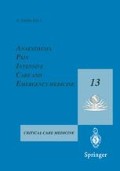Abstract
Substantial deviations from the normal dimension of body fluid compartments or spaces occur in severely ill patients. These abnormalities include changes in the absolute size of a given compartment, in its relative size with respect to other spaces or to total body water, or the development of non-functional compartments [1]. Since the consequences of fluid space abnormalities can be life-threatening, it is most important to recognize their presence, interpret properly their pathogenesis, and implement measures aimed at correcting these disorders. We describe below the most relevant disorders of fluid compartment dimensions in critically ill patients.
Access this chapter
Tax calculation will be finalised at checkout
Purchases are for personal use only
Preview
Unable to display preview. Download preview PDF.
References
Greco BA, Jacobson HR (1996) Fluid and electrolyte problems with surgery, trauma, and burns. In: Kokko JP, Tannen RL (eds) Fluids and electrolytes. WB Saunders, Philadelphia, pp 729–758
Adrogué HJ, Wesson DE (1994) Salt & Water. Blackwell’s basics of medicine, vol 3. Blackwell Scientific, Boston
Adrogué HJ, Madias NE (1997) Aiding fluid prescription for the dysnatremias. Intensive Care Med 23:309–316
Elwyn DH, Bryan-Brown CW, Shoemaker WC (1975) Nutritional aspects of body water dislocations in postoperative and depleted patients. Ann Surg 182:76–85
Moore FD et al (1963) The body cell mass and its supporting environment. WB Saunders, Philadelphia
Hood VL (1996) Fluid and electrolyte disturbances in starvation states. In: Kokko JP, Tannen RL (eds) Fluids and electrolytes. WB Saunders, Philadephia, pp 759–785
Bergstrom JP, Larsson J, Nordstrom H et al (1987) Influence of injury and nutrition on muscle water and electrolytes: effect of severe injury, burns and sepsis. Acta Chir Scand 153:261–266
Gatzen C, Scheltinga MR, Kimbrough TD et al (1992) Growth hormone attenuates the abnormal distribution of body water in critically ill surgical patients. Surgery 112:181–187
Blackburn GL, Bothe A (1978) Assessment of malnutrition in cancer patients. Cancer Bull 30:88–93
Pichard C, Fitting JW, Chevrolet JC (1998) Nutritional monitoring. In: Tobin MJ (ed) Principles and practice of intensive care monitoring. McGraw-Hill, New York, pp 1099–1124
Farber MO (1998) Monitoring of fluid balance. In: Tobin MJ (ed) Principles and practice of intensive care monitoring. McGraw-Hill, New York, pp 1077–1084
Haussinger D, Roth E, Lang F et al (1993) Cellular hydration state: an important determinant of protein catabolism in health and disease. Lancet 341:1330–1332
Author information
Authors and Affiliations
Editor information
Editors and Affiliations
Rights and permissions
Copyright information
© 1999 Springer-Verlag Italia
About this paper
Cite this paper
Adrogué, H.J. (1999). Dimension of Fluid Compartments in Severely Ill Patients. In: Gullo, A. (eds) Anaesthesia, Pain, Intensive Care and Emergency Medicine — A.P.I.C.E.. Springer, Milano. https://doi.org/10.1007/978-88-470-2145-7_37
Download citation
DOI: https://doi.org/10.1007/978-88-470-2145-7_37
Publisher Name: Springer, Milano
Print ISBN: 978-88-470-0051-3
Online ISBN: 978-88-470-2145-7
eBook Packages: Springer Book Archive

